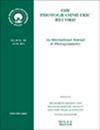通过星场参考来减少相机底片
IF 3.6
3区 地球科学
Q2 GEOGRAPHY, PHYSICAL
引用次数: 1
摘要
这个理论是用来确定一个点-物体的方向的,方法是把它和星场放在同一个底片上拍照,用星作为参考点。确定相机方向至少需要三颗参考星,超过三颗参考星的最小二乘解决方案是可能的。分析方法涉及九个“板常数”的联立方程的解。一旦找到了底片上的常数,物体的方向就可以很容易地从它在底片上的像的坐标得到。照相机定向的六个要素也可以很容易地从底片常数中求得。部分理论已经为飞马座电子计算机编好程序。附录给出了一种对方向余弦进行大气折射修正的简便方法。本文章由计算机程序翻译,如有差异,请以英文原文为准。
CAMERA PLATE‐REDUCTION BY MEANS OF STAR‐FIELD REFERENCE
The theory is developed for determining the direction of a point-object by photographing it on the same plate as a star field and using the stars as reference points. A minimum of three reference stars is necessary for determining the camera orientation and with more than three stars a least-squares solution is possible.
The method of analysis involves the solution of simultaneous equations for nine “plate constants”. Once the plate constants have been found, the direction of an object may readily be obtained from the coordinates of its image on the plate. The six elements of orientation of the camera may also readily be found from the plate constants. Part of the theory has been programmed for the Pegasus electronic computer. An appendix gives a convenient method of applying atmospheric refraction corrections to direction cosines.
求助全文
通过发布文献求助,成功后即可免费获取论文全文。
去求助
来源期刊

Photogrammetric Record
地学-成像科学与照相技术
CiteScore
3.60
自引率
25.00%
发文量
71
审稿时长
>12 weeks
期刊介绍:
The Photogrammetric Record is an international journal containing original, independently and rapidly refereed articles that reflect modern advancements in photogrammetry, 3D imaging, computer vision, and other related non-contact fields. All aspects of the measurement workflow are relevant, from sensor characterisation and modelling, data acquisition, processing algorithms and product generation, to novel applications. The journal provides a record of new research which will contribute both to the advancement of photogrammetric knowledge and to the application of techniques in novel ways. It also seeks to stimulate debate though correspondence, and carries reviews of recent literature from the wider geomatics discipline.
Relevant topics include, but are not restricted to:
- Photogrammetric sensor calibration and characterisation
- Laser scanning (lidar)
- Image and 3D sensor technology (e.g. range cameras, natural user interface systems)
- Photogrammetric aspects of image processing (e.g. radiometric methods, feature extraction, image matching and scene classification)
- Mobile mapping and unmanned vehicular systems (UVS; UAVs)
- Registration and orientation
- Data fusion and integration of 3D and 2D datasets
- Point cloud processing
- 3D modelling and reconstruction
- Algorithms and novel software
- Visualisation and virtual reality
- Terrain/object modelling and photogrammetric product generation
- Geometric sensor models
- Databases and structures for imaging and 3D modelling
- Standards and best practice for data acquisition and storage
- Change detection and monitoring, and sequence analysis
 求助内容:
求助内容: 应助结果提醒方式:
应助结果提醒方式:


